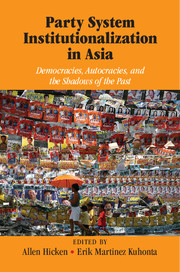Book contents
- Frontmatter
- Dedication
- Contents
- List of Figures
- List of Tables
- List of Contributors
- Acknowledgments
- 1 Introduction: Rethinking Party System Institutionalization in Asia
- 2 The Antidemocratic Potential of Party System Institutionalization: Malaysia as Morality Tale?
- 3 Institutionalized Succession and Hegemonic Party Cohesion in Singapore
- 4 Party System Institutionalization in Japan
- 5 Long in the Making: Taiwan’s Institutionalized Party System
- 6 The Making and Unmaking of the Communist Party and Single-Party System of Vietnam
- 7 The Institutionalization of the Communist Party and the Party System in China
- 8 Party System Institutionalization in India
- 9 Party and Party System Institutionalization in Cambodia
- 10 Explaining Party System Institutionalization in Indonesia
- 11 South Korea’s Weakly Institutionalized Party System
- 12 Thailand’s Feckless Parties and Party System: A Path-Dependent Analysis
- 13 Party and Party System Institutionalization in the Philippines
- 14 Party System Institutionalization: Reflections Based on the Asian Cases
- Index
- References
12 - Thailand’s Feckless Parties and Party System: A Path-Dependent Analysis
Published online by Cambridge University Press: 18 December 2014
- Frontmatter
- Dedication
- Contents
- List of Figures
- List of Tables
- List of Contributors
- Acknowledgments
- 1 Introduction: Rethinking Party System Institutionalization in Asia
- 2 The Antidemocratic Potential of Party System Institutionalization: Malaysia as Morality Tale?
- 3 Institutionalized Succession and Hegemonic Party Cohesion in Singapore
- 4 Party System Institutionalization in Japan
- 5 Long in the Making: Taiwan’s Institutionalized Party System
- 6 The Making and Unmaking of the Communist Party and Single-Party System of Vietnam
- 7 The Institutionalization of the Communist Party and the Party System in China
- 8 Party System Institutionalization in India
- 9 Party and Party System Institutionalization in Cambodia
- 10 Explaining Party System Institutionalization in Indonesia
- 11 South Korea’s Weakly Institutionalized Party System
- 12 Thailand’s Feckless Parties and Party System: A Path-Dependent Analysis
- 13 Party and Party System Institutionalization in the Philippines
- 14 Party System Institutionalization: Reflections Based on the Asian Cases
- Index
- References
Summary
Introduction
Where the instrumentalities of popular control are, if not absent, at least weak or embryonic, as they are in Thailand, national politics becomes more simply a struggle for power as an end in itself among competing cliques and factions.
–Fred RiggsIt will be useful to begin looking at the Thai party system by referring to a classic work on Thai politics – that of Fred Riggs. If we think of the “instrumentalities of popular control” as political parties, one is struck by the validity of Riggs’s observation that politics is largely “a struggle for power as an end in itself among competing cliques and factions.” Since the birth of its parties in 1932, Thailand’s party system has been devoid of real programmatic differences. Instead, the system has largely been consumed by elites running empty political shells in the pursuit of spoils for their factions. Only in recent years has the party system begun to exhibit programmatic differences among its main contenders. Overall, however, the historical tendency of Thailand’s party system has been one of institutional fecklessness and ideological vacuousness.
Thailand’s party system is notorious for its low level of institutionalization. Underscoring this assessment, James Ockey writes: “There is widespread agreement that parties are too weak while their factions are too strong . . . The importance of this consensus in the literature cannot be overstated.” Using three of the components of Mainwaring and Scully’s definition of party system institutionalization – stability in the rules and nature of interparty competition, stable roots in society, and organizational autonomy and strength – it is clear that on all these attributes the Thai party system scores low.
Information
- Type
- Chapter
- Information
- Party System Institutionalization in AsiaDemocracies, Autocracies, and the Shadows of the Past, pp. 280 - 306Publisher: Cambridge University PressPrint publication year: 2014
References
Accessibility standard: Unknown
Why this information is here
This section outlines the accessibility features of this content - including support for screen readers, full keyboard navigation and high-contrast display options. This may not be relevant for you.Accessibility Information
- 7
- Cited by
